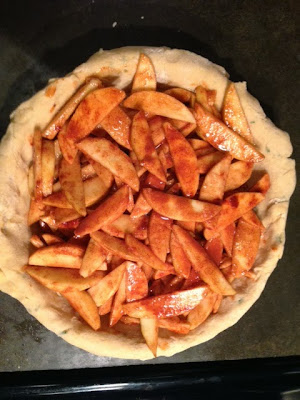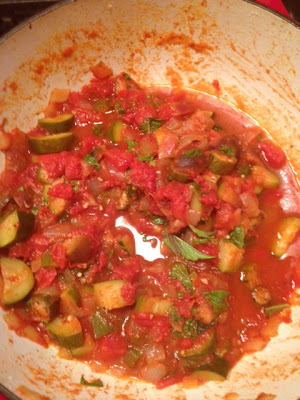This pie is a showstopper, but not just because it's pretty. It's delicious as well. I've always been a big fan of herbs and fruit together because, if they're done right, they can add another layer of unexpected, savory flavor. Adding rosemary and a bit of cornmeal in the crust accomplishes this quite nicely here.
This pie takes a good amount of time to prepare and make. It tastes like it took forever because it kind of does. I know that goes against my love for simple recipes, but sometimes you have to do more work to get a better result.
Ingredients
For the crust:
2 cups unbleached all-purpose flour, plus more for dusting
1/2 cup evaporated cane sugar
2 tbsp cornmeal
1/2 tbsp chopped rosemary
1 tsp kosher salt
12 tbsp Earth Balance buttery stick, cubed and chilled
1/2 cup ice-cold water
For the filling:
3 lbs of sweet McIntosh apples, peeled, cored and sliced
3/4 cup evaporated cane sugar
3 tbsp cornstarch
1 1/2 tbsp ground cinnamon
1 tbsp fresh lemon juice
1 1/2 tsp vanilla
1/2 tsp kosher salt
3 tbsp Earth Balance buttery stick, cubed and chilled
Make the crust: Put all the ingredients except the water into a food processor and pulse them until the butter has been incorporated and reduced to pea-sized bits. It's important to have very cold butter for this, so what I do is cube up the butter before I start anything else. Then I put it in the freezer while I get the other ingredients together. It's never more than a few minutes, but it firms the butter up nicely. If you have room-temperature butter, it'll cream together with all the other ingredients (think chocolate chip cookie dough) and will be a total mess.
Before:
After:
Add the water through the chute and pulse it continuously until the dough comes together.
Divide the dough into 2/3 and 1/3 portions. Roll them out separately into flat disks and wrap them both in plastic wrap and put them in the fridge for an hour.
Once an hour has passed, on a floured surface, roll out the larger piece of dough into a 12-inch round. Gently roll it over your rolling pin, pick it up and roll it out over your pie pan. Center it so that it hangs over the pie plate evenly on all sides, then trim the excess until there's only about an inch of overhanging dough around the whole diameter of the pan.
Make the filling: While the doughs are chilling, you can peel and slice your apples and then combine them with the cornstarch, cinnamon, lemon juice, vanilla and salt in a large bowl. A few minutes before you assemble the pie, go ahead and cube up the butter. You won't need to put this butter into the freezer or worry about it staying really cold.
Assemble the pie: Once the dough has chilled for 30 minutes, pour the apples into the pie pan, spreading them out evenly. Dot the apples with the butter cubes, tucking some of them into the apple mixture.
Here's the part that seems tricky, but really isn't. Lay four of the dough strips horizontally across the top of the pie, then fold the first and third strips halfway back on top of themselves. Lay another stripe perpendicular to them, just off center.
Unfold the first and third strips and then fold back the second and fourth strips and lay another strip perpendicular to those.
Repeat the weave pattern on the other side until you have the full effect. Put the completed pie into the fridge for 30 minutes.
Preheat your oven to 400 degrees and bake the pie until the crust is golden and the apples are tender, about 1 hour. Let the pie cool completely before serving.















